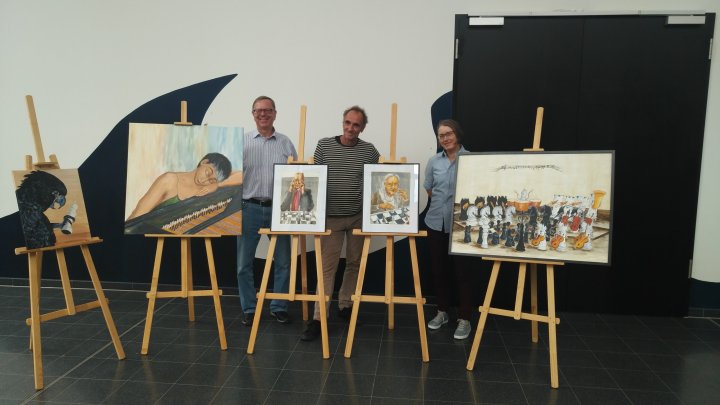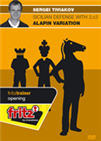Chess and Art in Dortmund
The cultural program focuses on chess, music and art and alongside the Sparkassen Chess Meeting in the Orchesterzentrum NRW, a pair of Dortmund artists, Helga Jonschker and Peter Kroeker, will exhibit their chess-themed artwork.
As a member of the Orchesterzentrum, she has gained insights into the chess in recent years on account of the cooperation with the Sparkassen Chess Meeting. This was the starting point for artwork that represent the symbiosis between chess and music. The colourful works convey an impression of her artistic passion, which in part wants to be understood with a wink.
Since 2008, Jonschker mainly paints in acrylic. Painting relaxes her, and she can immerse herself in different worlds through her work. In her paintings, she likes to process the journeys made in recent years and, through painting and the resulting images, relives the experiences time and again. Whether painted, glazed or filled: Helga Jonschker loves rich colours, which gives her pictures radiance. The works are also characterized by meticulous design or proximity to reality. A great role model is, among others, the work of Edward B. Gordon, on which an extra painting for this exhibition is based.

Gert Kolbe, Peter Kroeker and Helga Jonschker with their pictures
Peter Kroeker began his artistic career as a "master student" of his grandmother, who created countless elves and princess drawings in her dining room studio. Peter Kroeker's childlike eyes loved these pictures.
After a few years as a carpenter journeyman, at the age of 30, the late decision to study graphic design at the FH Dortmund. Nevertheless, Kroeker regards himself today as a self-taught artist. His artistic interest is primarily the representation of humanity. Usually working with acrylic paints, but also with oil pen, spray paint, among others, his creations are sometimes relatively realistic, sometimes rather coarse, in comic style or as a line drawing.
Chess was previously unknown to Kroeker and maybe that's why it's a sexy topic for him. "What do I see in it? What can I work out of it?" he asked. He finds it very interesting to observe the concentration in the faces of the players, the tension, the disappointment or the relief. Also, the pieces offer a fantasy-inspired aspect as characters; the king, the queen, the pawns, are seen in different contexts and represented detached from the chessboard.
Source: Press Release
Radjabov ½-½ Wojtaszek
In the first round Daniel Fridman won against Kaido Kulaots, while Leinier Dominguez Perez beat Liviu-Dieter Nisipeanu. Richard Rapport left a strong impression thanks to his victory against Ian Nepomniachtchi. The game between Teimour Radjabov and Radoslaw Wojtaszek ended in a draw. This game was the first to end this afternoon — for a reason:
 Pavel Eljanov explains in depth what Gyula Breyer already saw in 1911 and what became an opening choice of the likes of Kasparov, Kramnik, Anand or Carlsen. The Breyer Variation, which is characterised by the knight retreat to b8.
Pavel Eljanov explains in depth what Gyula Breyer already saw in 1911 and what became an opening choice of the likes of Kasparov, Kramnik, Anand or Carlsen. The Breyer Variation, which is characterised by the knight retreat to b8.
Teimour Radjabov and Radoslaw Wojtaszek played a sharp game, but it led to a draw
Dominguez 1-0 Nisipeanu
After Nisipeanu's double-edged centre thrust d6-d5, Dominguez not only won a pawn, but also had the more active heavy pieces:
 The Sicilian has been known for decades as the most reliable way for Black to obtain an unbalanced but good position. Among the most popular Sicilians at the top level the two that certainly stand out are the Najdorf and the Paulsen.
The Sicilian has been known for decades as the most reliable way for Black to obtain an unbalanced but good position. Among the most popular Sicilians at the top level the two that certainly stand out are the Najdorf and the Paulsen.
The tournament started with a win for Dominguez (right)
Fridman 1-0 Kulaots
Kaido Kulaot "forgot" to castle in the opening phase, giving Fridman a structural advantage. However, a tactical back and forth game gave chances to both sides:
 Sergei Tiviakov started playing the line 1.e4 c5 2.c3 in the Sicilian Defence as White in 1988. Since then, he has employed it in more than 100 games, including a yearlong period when he I managed to win twelve 2.c3-games in a row. White tries to occupy the centre with a second pawn, and Black must know his stuff very well in order to be able to equalize. And this is only possible with 2...Nf6 – all other lines give the first player a small edge everywhere. Especially against stronger opponents, 2.c3 is an excellent weapon.
Sergei Tiviakov started playing the line 1.e4 c5 2.c3 in the Sicilian Defence as White in 1988. Since then, he has employed it in more than 100 games, including a yearlong period when he I managed to win twelve 2.c3-games in a row. White tries to occupy the centre with a second pawn, and Black must know his stuff very well in order to be able to equalize. And this is only possible with 2...Nf6 – all other lines give the first player a small edge everywhere. Especially against stronger opponents, 2.c3 is an excellent weapon.
In a wild game Daniel Fridman had a better view
Rapport 1-0 Nepomniachtchi
From a certain point of view, Richard Rapport had the better piece placement and prosecuted this advantage quite strongly:
 The aim of these Dvd's is to build a repertoire after 1.c4 and 2.g3 for White. The first DVD includes the systems 1...e5, the Dutch and Indian setups. The second DVD includes the systems with 1...c5, 1...c6 and 1...e6.
The aim of these Dvd's is to build a repertoire after 1.c4 and 2.g3 for White. The first DVD includes the systems 1...e5, the Dutch and Indian setups. The second DVD includes the systems with 1...c5, 1...c6 and 1...e6.
The Hungarian Grandmaster Richard Rapport delivered a strong performance today
Results of Round 1
Current standings
Live games
All games
Translation from German: Macauley Peterson
Links
























